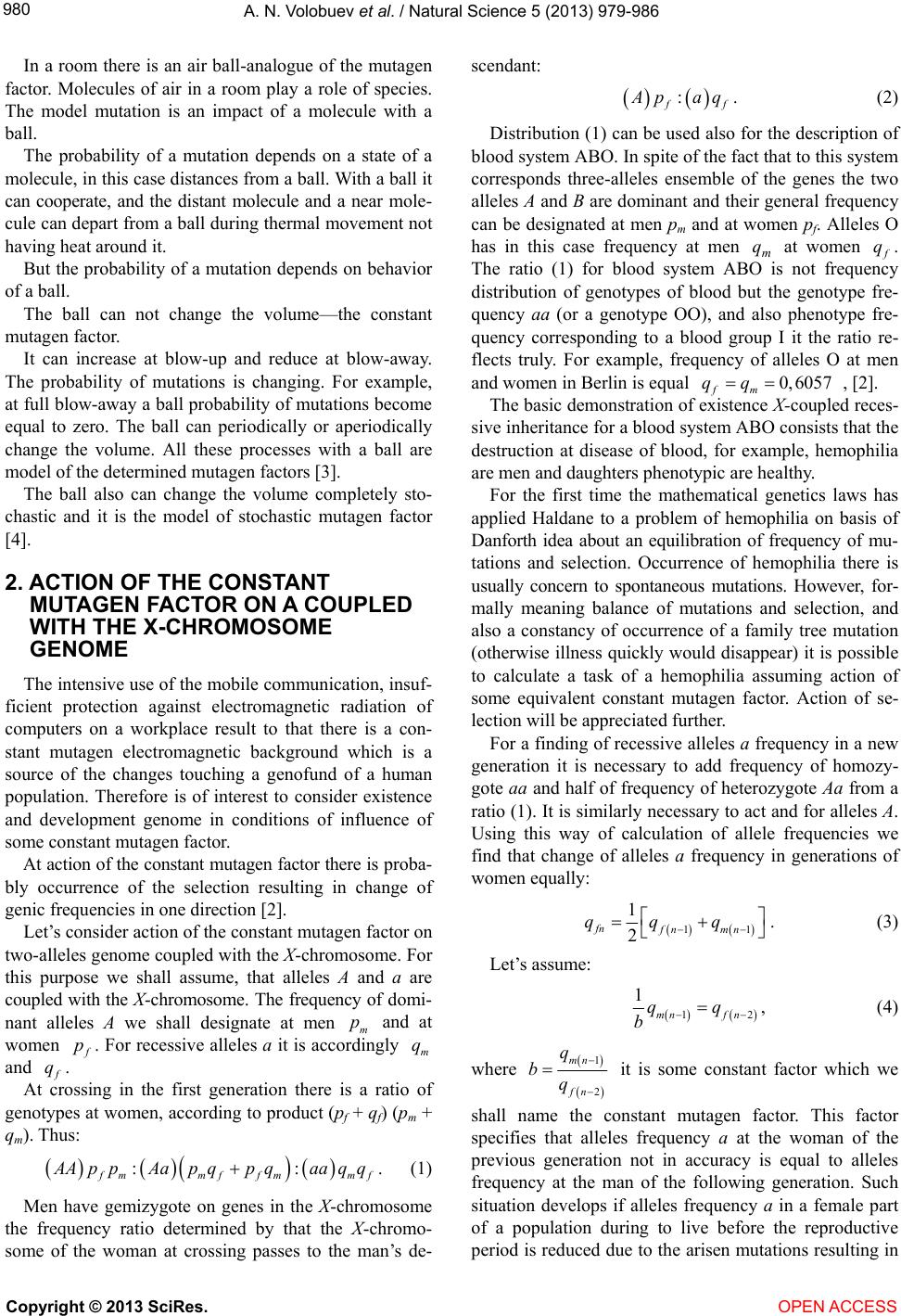
A. N. Volobuev et al. / Natural Science 5 (2013) 979-986
980
In a room there is an air ball-analogue of the mutagen
factor. Molecules of air in a room play a role of species.
The model mutation is an impact of a molecule with a
ball.
The probability of a mutation depends on a state of a
molecule, in this case distances from a ball. With a ball it
can cooperate, and the distant molecule and a near mole-
cule can depart from a ball during thermal movement not
having heat around it.
But the probability of a mutation depends on behavior
of a ball.
The ball can not change the volume—the constant
mutagen factor.
It can increase at blow-up and reduce at blow-away.
The probability of mutations is changing. For example,
at full blow-away a ball probability of mutations become
equal to zero. The ball can periodically or aperiodically
change the volume. All these processes with a ball are
model of the determined mutagen factors [3].
The ball also can change the volume completely sto-
chastic and it is the model of stochastic mutagen factor
[4].
2. ACTION OF THE CONSTANT
MUTAGEN FACTOR ON A COUPLED
WITH THE Х-CHROMOSOME
GENOME
The intensive use of the mobile communication, insuf-
ficient protection against electromagnetic radiation of
computers on a workplace result to that there is a con-
stant mutagen electromagnetic background which is a
source of the changes touching a genofund of a human
population. Therefore is of interest to consider existence
and development genome in conditions of influence of
some constant mutagen factor.
At action of the constant mutagen factor there is proba-
bly occurrence of the selection resulting in change of
genic frequencies in one direction [2].
Let’s consider action of the constant mutagen factor on
two-alleles genome coupled with the Х-chromosome. For
this purpose we shall assume, that alleles A and a are
coupled with the Х-chromosome. The frequency of domi-
nant alleles A we shall designate at men m and at
women
p
p. For recessive alleles a it is accordingly
and
m
q
q.
At crossing in the first generation there is a ratio of
genotypes at women, according to product (pf + qf) (pm +
qm). Thus:
::
mmffmmf
AppAa pqpqaaqq. (1)
Men have gemizygote on genes in the Х-chromosome
the frequency ratio determined by that the Х-chromo-
some of the woman at crossing passes to the man’s de-
scendant:
:
f
paq. (2)
Distribution (1) can be used also for the description of
blood system АВO. In spite of the fact that to this system
corresponds three-alleles ensemble of the genes the two
alleles A and B are dominant and their general frequency
can be designated at men pm and at women pf. Alleles O
has in this case frequency at men m at women q
q.
The ratio (1) for blood system АВO is not frequency
distribution of genotypes of blood but the genotype fre-
quency aa (or a genotype OO), and also phenotype fre-
quency corresponding to a blood group I it the ratio re-
flects truly. For example, frequency of alleles O at men
and women in Berlin is equal , [2].
0,6057 qq
fm
The basic demonstration of existence Х-coupled reces-
sive inheritance for a blood system АВO consists that the
destruction at disease of blood, for example, hemophilia
are men and daughters phenotypic are healthy.
For the first time the mathematical genetics laws has
applied Haldane to a problem of hemophilia on basis of
Danforth idea about an equilibration of frequency of mu-
tations and selection. Occurrence of hemophilia there is
usually concern to spontaneous mutations. However, for-
mally meaning balance of mutations and selection, and
also a constancy of occurrence of a family tree mutation
(otherwise illness quickly would disappear) it is possible
to calculate a task of a hemophilia assuming action of
some equivalent constant mutagen factor. Action of se-
lection will be appreciated further.
For a finding of recessive alleles a frequency in a new
generation it is necessary to add frequency of homozy-
gote aa and half of frequency of heterozygote Aa from a
ratio (1). It is similarly necessary to act and for alleles A.
Using this way of calculation of allele frequencies we
find that change of alleles a frequency in generations of
women equally:
1
1
2
fn fn mn
qqq
1
. (3)
Let’s assume:
1
1
mnf n
qq
b2
, (4)
where
1
2
mn
fn
q
bq
it is some constant factor which we
shall name the constant mutagen factor. This factor
specifies that alleles frequency a at the woman of the
previous generation not in accuracy is equal to alleles
frequency at the man of the following generation. Such
situation develops if alleles frequency a in a female part
of a population during to live before the reproductive
period is reduced due to the arisen mutations resulting in
Copyright © 2013 SciRes. OPEN ACCESS